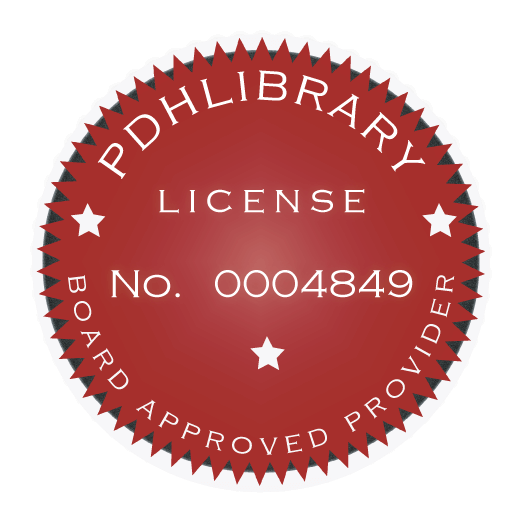HYDROLOGY, PART 1 - RAINFALL/RUNOFF PROCESSES
Course Description:
This introductory engineering continuing education course will cover the basic concepts of the processes of rainfall and how that rainfall becomes surface runoff. Precipitation topics include forms of precipitation, types of storms and characteristics of these events. As the rainfall is converted to runoff, a number of process reduce the total amount of water that runs off. These abstractions are described in this course. The characteristics of runoff including peak flows, hydrographs, total volume and frequency will be covered.
The course will describe the factors that impact runoff, including drainage area, slope, roughness, channel length and drainage density. Illustrations of the runoff process will be provided including the impacts of interception and infiltration. Finally, a description of travel time through a drainage will be provided. This course is based primarily on information from Federal Highway Administration publication HDS-2, Hydrology.
Course Outline:
• PRECIPITATION
o Forms of Precipitation
o Types of Precipitation (by Origin)
• Convective Storms
• Orographic Storms
• Cyclonic Storms
• Hurricanes and Typhoons
o Characteristics of Rainfall Events
o Intensity-Duration-Frequency Curves
• HYDROLOGIC ABSTRACTIONS
o Evaporation
o Transpiration
o Interception
o Infiltration
o Depression Storage
o Detention Storage
o Total Abstraction Methods
• CHARACTERISTICS OF RUNOFF
o Peak Discharge
o Time Variation (Hydrograph)
o Stage-Discharge
o Total Volume
o Frequency
o Return Period
• EFFECTS OF BASIN CHARACTERISTICS ON RUNOFF
o Drainage Area
o Slope
o Hydraulic Roughness
o Storage
o Drainage Density
o Channel Length
o Antecedent Moisture Conditions
o Urbanization
o Other Factors
• ILLUSTRATION OF THE RUNOFF PROCESSES
o Rainfall Input
o Interception
o Depression Storage
o Infiltration
o Rainfall Excess
o Detention Storage
o Local Runoff
o Outflow Hydrograph
• TRAVEL TIME
o Time of Concentration
o Velocity Method
o Sheet-Flow Travel Time
o Shallow Concentrated Flow
o Pipe and Channel Flow
Learning Objectives:
At the conclusion of this course, the user will:
• Have a basic understanding of the forms of precipitation and the types of storms that generate these events
• Understand how abstractions such as evaporation, interception and infiltration impact runoff
• Understand the important characteristics of runoff, such as peak flows and total volume.
• Understand how factors such as drainage area, slope, roughness and drainage density impact both peak flows and total runoff volume.
• Understand the concept of time of concentration and how time of concentration can be calculated
HYDROLOGY, PART 2 – PEAK FLOW FOR UNGAGED SITES
Course Description:
This course will cover the concepts of how to estimate various return period peak flow values for locations that do not have nearby USGS stream gages. While various statistical analysis can be employed on streams that have USGS gages, established peak flow values for other locations is often necessary. Methods presented include regression approaches such as the USGS Regression Equations, USGS Urban Watershed Studies, and the USGS StreamStats software. The course also covers the SCS Graphical Peak Discharge Method and the Rational Method. The use of the Index Flood Method and Peak Discharge Envelope Curve are included.
The course will describe the factors that need to be determined in order to appropriately use the regression equations. It will also describe the basic use of the StreamStats software which allows for rapid calculation of all necessary regression equation parameters. The use of the SCS Graphical Peak Discharge Method will be described in detail, including examples. This course is based primarily on information from Federal Highway Administration publication HDS-2, Hydrology and the USGS StreamStats software.
Course Outline:
• REGIONAL REGRESSION EQUATIONS
o Analysis Procedure
o USGS Regression Equations
• Hydrologic Flood Regions
• Assessing Prediction Accuracy
• Comparison with Gaged Estimates
• Application and Limitations
o USGS Urban Watershed Studies
• Peak Discharge Equations
• Basin Development Factor
• Effects of Future Urbanization
• Local Urban Equations
o FHWA Regression Equations
o USGS Streamstats Program
• SCS GRAPHICAL PEAK DISCHARGE METHOD
o Runoff Depth Estimation
o Soil Group Classification
o Cover Complex Classification
o Curve Number Tables
o Estimation of CN Values for Urban Land Uses
o Effect of Unconnected Impervious Area on Curve Numbers
o Ia/P Parameter
o Peak Discharge Estimation
• RATIONAL METHOD
o Assumptions
o Estimating Input Requirements
o Check for Critical Design Condition
• INDEX FLOOD METHOD
o Procedure for Analysis
o Other Considerations
• PEAK DISCHARGE ENVELOPE CURVES
Learning Objectives:
At the conclusion of this course, the user will:
• Understand how to use the USGS Regional Regression Equations
• Understand how the USGS StreamStats software can be used to obtain more accurate estimates of basin parameters and to estimate peak flows.
• Understand how to use the SCS Graphical Peak Discharge Method.
• Understand the factors involved in the use of the Rational Equation and how to estimate these factors and compute peak flows.
• Understand how the Index Flood Method and Peak Discharge Envelope Curves can be used to estimate peak flows.

